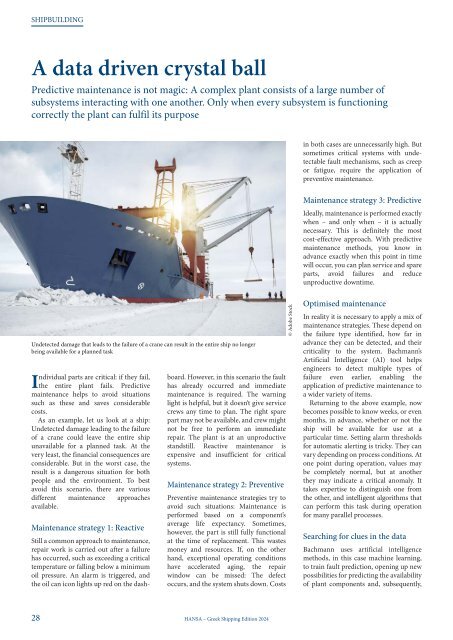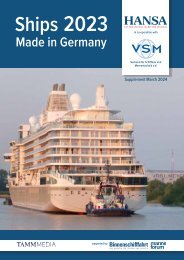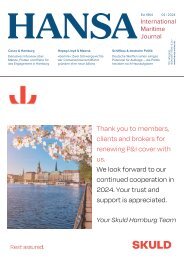HANSA Greek Shipping 2024 Posidonia Edition
SHIPPING: Greece in numbers / Interview Theodore Vokos, Managing Director, Posidonia Exhibitions / Interview Elias Kariambas, Vice President, Regional Business Development, Greece / Interview Michael Suhr, Senior Vice President and Regional Director North Europe at Korean Register (KR) / Greek shipowners on the way to Net Zero / Greek company’s strong in Capesize sector / Personal support as a USP SHIPBUILDING: Welcome to Posidonia 2024 / Setting sail for success in Greek market / Interview Jörg Karthaus, Head of Sales, Pleiger Maschinenbau / A data driven crystal ball / LNG fuelled LCO2 carriers: going for growth / 75 years of MMG Propeller – an eventful success story / Interview Lars Greitsch, CEO at Mecklenburger Metallgus (MMG)
SHIPPING: Greece in numbers / Interview Theodore Vokos, Managing Director, Posidonia Exhibitions / Interview Elias Kariambas, Vice President,
Regional Business Development, Greece / Interview Michael Suhr, Senior Vice President and Regional Director North Europe at Korean Register (KR) / Greek shipowners on the way to Net Zero / Greek company’s strong in Capesize sector / Personal support as a USP
SHIPBUILDING: Welcome to Posidonia 2024 / Setting sail for success in Greek market / Interview Jörg Karthaus, Head of Sales, Pleiger Maschinenbau / A data driven crystal ball / LNG fuelled LCO2 carriers: going for growth / 75 years of MMG Propeller – an eventful success story / Interview Lars Greitsch, CEO at Mecklenburger Metallgus (MMG)
You also want an ePaper? Increase the reach of your titles
YUMPU automatically turns print PDFs into web optimized ePapers that Google loves.
SHIPBUILDING<br />
A data driven crystal ball<br />
Predictive maintenance is not magic: A complex plant consists of a large number of<br />
subsystems interacting with one another. Only when every subsystem is functioning<br />
correctly the plant can fulfil its purpose<br />
in both cases are unnecessarily high. But<br />
sometimes critical systems with undetectable<br />
fault mechanisms, such as creep<br />
or fatigue, require the application of<br />
preventive maintenance.<br />
Maintenance strategy 3: Predictive<br />
Ideally, maintenance is performed exactly<br />
when – and only when – it is actually<br />
necessary. This is definitely the most<br />
cost-effective approach. With predictive<br />
maintenance methods, you know in<br />
advance exactly when this point in time<br />
will occur, you can plan service and spare<br />
parts, avoid failures and reduce<br />
unproductive downtime.<br />
Undetected damage that leads to the failure of a crane can result in the entire ship no longer<br />
being available for a planned task<br />
ndividual parts are critical: if they fail,<br />
Ithe entire plant fails. Predictive<br />
maintenance helps to avoid situations<br />
such as these and saves considerable<br />
costs.<br />
As an example, let us look at a ship:<br />
Undetected damage leading to the failure<br />
of a crane could leave the entire ship<br />
unavailable for a planned task. At the<br />
very least, the financial consequences are<br />
considerable. But in the worst case, the<br />
result is a dangerous situation for both<br />
people and the environment. To best<br />
avoid this scenario, there are various<br />
different maintenance approaches<br />
available.<br />
Maintenance strategy 1: Reactive<br />
Still a common approach to maintenance,<br />
repair work is carried out after a failure<br />
has occurred, such as exceeding a critical<br />
temperature or falling below a minimum<br />
oil pressure. An alarm is triggered, and<br />
the oil can icon lights up red on the dashboard.<br />
However, in this scenario the fault<br />
has already occurred and immediate<br />
maintenance is required. The warning<br />
light is helpful, but it doesn‘t give service<br />
crews any time to plan. The right spare<br />
part may not be available, and crew might<br />
not be free to perform an immediate<br />
repair. The plant is at an unproductive<br />
standstill. Reactive maintenance is<br />
expensive and insufficient for critical<br />
systems.<br />
Maintenance strategy 2: Preventive<br />
Preventive maintenance strategies try to<br />
avoid such situations: Maintenance is<br />
performed based on a component’s<br />
average life expectancy. Sometimes,<br />
however, the part is still fully functional<br />
at the time of replacement. This wastes<br />
money and resources. If, on the other<br />
hand, exceptional operating conditions<br />
have accelerated aging, the repair<br />
window can be missed: The defect<br />
occurs, and the system shuts down. Costs<br />
© Adobe Stock<br />
Optimised maintenance<br />
In reality it is necessary to apply a mix of<br />
maintenance strategies. These depend on<br />
the failure type identified, how far in<br />
advance they can be detected, and their<br />
criticality to the system. Bachmann’s<br />
Artificial Intelligence (AI) tool helps<br />
engineers to detect multiple types of<br />
failure even earlier, enabling the<br />
application of predictive maintenance to<br />
a wider variety of items.<br />
Returning to the above example, now<br />
becomes possible to know weeks, or even<br />
months, in advance, whether or not the<br />
ship will be available for use at a<br />
particular time. Setting alarm thresholds<br />
for automatic alerting is tricky. They can<br />
vary depending on process conditions. At<br />
one point during operation, values may<br />
be completely normal, but at another<br />
they may indicate a critical anomaly. It<br />
takes expertise to distinguish one from<br />
the other, and intelligent algorithms that<br />
can perform this task during operation<br />
for many parallel processes.<br />
Searching for clues in the data<br />
Bachmann uses artificial intelligence<br />
methods, in this case machine learning,<br />
to train fault prediction, opening up new<br />
possibilities for predicting the availability<br />
of plant components and, subsequently,<br />
28 <strong>HANSA</strong> – <strong>Greek</strong> <strong>Shipping</strong> <strong>Edition</strong> <strong>2024</strong>

















